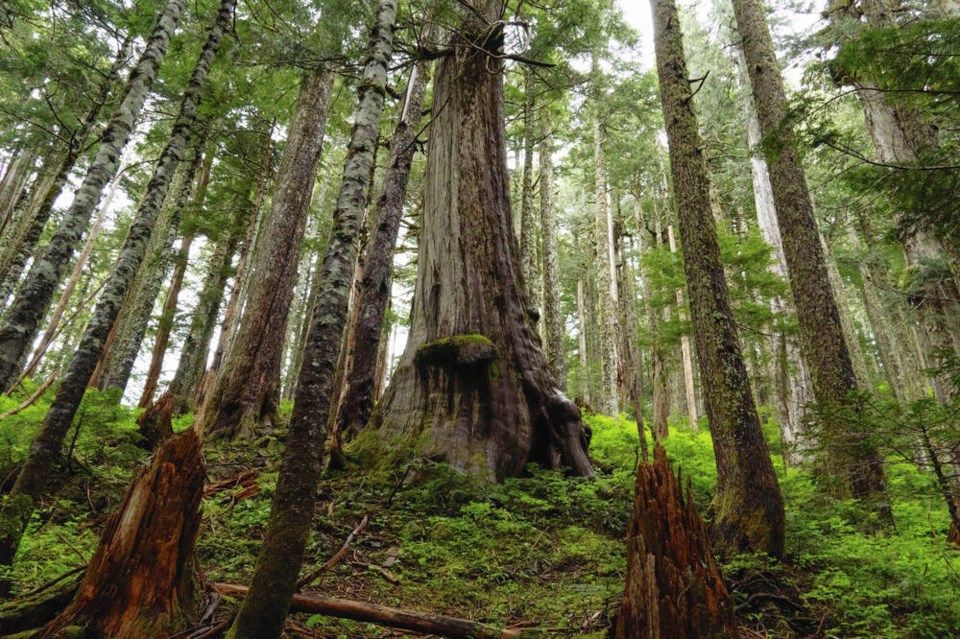Old growth logging has been slowly crimped in B.C. over the years, but measures announced Tuesday could see it grinding almost to a halt in the most contentious stands of timber.
The NDP government, which has boasted about protecting more than 200,000 hectares of old-growth forest in the last few years, is going to temporarily defer harvest of another 2.6 million hectares scattered in patches all over the province. Those stands are made up of big trees, rare ecosystems and/or ancient forests, three categories that draw the most sustained controversy. Those categories together are considered forests at risk of irreversible loss.
Deferring logging on that scale is a significant move. It constitutes a big reduction in the harvest that will have drastic impacts on the forest industry and it will start immediately.
Veteran forester Gary Merkel, who worked on an advisory committee that drafted the recommendations, summed it up: “It’s an exciting and scary time.”
The deferrals are not considered full protection — yet. They’re billed as temporary two-year measures to allow for new management approaches to be developed. But it’s hard to imagine logging resuming in those areas to any degree, now that the lines have been drawn on the map.
As a measure of how quickly it is being imposed, B.C. Timber Sales, the agency that offers Crown timber for sale to regulate part of the market, on Tuesday cancelled all advertised timber sales from the new deferral areas. The volume amounts to about one-third of their annual business.
And First Nations, which will have a crucial say in how the new regime is imposed, have been given just 30 days to indicate initial views on deferrals in their territories.
Most of the emphasis Tuesday was on preservation. The enormous potential cost was downplayed. On top of the foregone tax and stumpage revenue, the government estimates 4,500 jobs are at stake. It said laid-off workers could be helped with enhancements to existing programs.
Short-term programs to help forest contractors explore new work, skills training, community rapid response teams for hard-hit areas and retirement bridging, were cited, with minimal cost estimates.
The only dollar figure revealed was a skimpy $12.7 million over three years to cover First Nations costs’ of responding to the deferrals.
It fell to the opposition B.C. Liberals to highlight the potential further costs. Former forests minister Mike de Jong cited reports that 12 mills might close and far more jobs — up to 15,000 — might be lost.
“Forest-dependent families won’t be smiling at the end of the day, I can guarantee you that.”
Also downplayed were the significant arguments that are going to come up. The Forests Ministry suggested that licensees who have paid for the rights could “volunteer” to pause the harvest while the deferrals are finalized.
That may be conceivable when a forest company has a partnership with a First Nation that favours the deferral.
But the other option the ministry said it will use if necessary is to force the issue. It can rescind approved permits by ministerial order and prevent the issuance of new ones.
The law allows the minister to rescind them for up to 10 years, and any talk of compensation would be delayed for up to four years, which would penalize companies.
On the other side of the argument there are concerns the deferrals will force First Nations with logging interests to increase harvesting in remaining old-growth areas.
Even before the announcement, the First nations Forestry Council objected to being asked about the deferrals so late in the process of drafting them.
Klay Tindall, Lil’wat Forestry operations manager, said that nation spent several million dollars buying a licence so it could have a better say, “and now the government comes along and is trying to tell the nation what they can and can’t do.”
The announcement was based on a wealth of new mapping data that hint the argument is far from over.
The three categories of old growth in the new maps — “big trees,” “rare eco-system” and “ancient forest” make up 7.6 million hectares, of which 2.6 million is protected. Tuesday’s announcement could double that area.
But there would still be about 2.4 million hectares unprotected, most of it big trees. Preservationists are on a winning streak and will be setting their sights on the rest.

